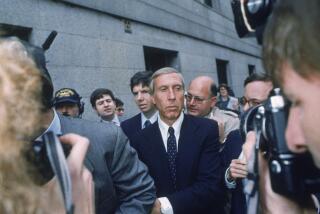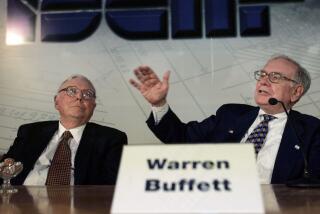Insider-trading trial recalls Wall St. anxiety
- Share via
Reporting from New York — The fall of 2008 was a worrisome time, even for Goldman Sachs Group Inc., Wall Street’s strongest investment bank, its chief executive said under oath.
Testifying in a high-profile Wall Street criminal trial, Goldman CEO Lloyd Blankfein said he felt “very nervous” at the height of the financial crisis before the firm secured a $5-billion infusion from legendary investor Warren Buffett.
Blankfein was called as a government witness in the federal insider-trading trial of Raj Rajaratnam, a former hedge fund manager accused of illegally profiting from confidential information about Goldman and a number of other companies during the crisis.
Despite being forced to recall a time when investors wondered which financial giant would be the next to collapse, Blankfein’s testimony Wednesday was surely more pleasant than his appearance last year before a hostile congressional committee looking into Goldman’s treatment of clients during the crisis.
The government lawyers in the Rajaratnam trial treated Blankfein with kid gloves, interrupting the testimony of another witness to accommodate the executive’s schedule. And when the defendant’s attorney began a cross-examination, he said, “I’ll try not to keep you long — I know that you’re busy.”
The prosecutors portrayed Goldman as an unwitting victim of Rajat Gupta, a former member of Goldman’s board and a friend and business associate of Rajaratnam.
The Securities and Exchange Commission this month accused Gupta, former head of consulting giant McKinsey & Co., of tipping off Rajaratnam about information he received during Goldman board meetings. Gupta has denied any wrongdoing and recently sued the SEC, accusing the agency of unfairly denying him a jury trial by bringing its case against him in an administrative proceeding.
Prosecutors played a recording of a wire-tapped 2008 phone call in which Gupta can be heard telling Rajaratnam that the Goldman board had recently talked about buying a troubled financial firm such as Wachovia, a commercial bank, or insurer American International Group Inc. On the recording, Gupta describes Goldman as “an opportunistic group.”
Assistant U.S. Atty. Andrew Michaelson asked Blankfein, “In this call did Rajat Gupta violate Goldman Sachs confidentiality policy?”
“Uh, yes,” Blankfein said. “My sense of it, yes.”
Goldman, the most storied and successful bank on Wall Street, is known for avoiding the public eye and Blankfein explained why Gupta’s alleged leaks were problematic for the firm: “We want to control our communications with the outside world.”
As he was in his congressional testimony last year, Blankfein was unfailingly polite, carefully considering each question.
The calls between Gupta and Rajaratnam took place as the financial crisis approached a climax, at what Blankfein called a “time of great uncertainty and confusion in the market.”
Goldman executives have frequently said the bank would have weathered the crisis even without a $10-billion government infusion under the Troubled Asset Relief Program.
But Blankfein testified that in the month after Lehman Bros. failed in September 2008, Goldman itself was in the red, contrary to what Wall Street analysts thought.
“We were losing money,” he said.
“What was the significance of that?” Michaelson asked.
“We generally make money,” Blankfein answered.
Buffett’s holding company, Berkshire Hathaway, made its investment in Goldman shortly before the firm got money from TARP. Goldman wouldn’t have taken Buffett’s money if it knew the government was about to step in, Blankfein said.
“TARP was a bigger amount and on much more favorable terms,” he said.
Berkshire received an annual dividend of 10% a year on its preferred shares in Goldman, while the U.S. Treasury received only a 5% payout on its stake in the company.
“The government didn’t charge us nearly as much as Warren Buffett,” Blankfein testified, drawing a laugh from the packed Manhattan courtroom.
Marking a full recovery from the crisis, Goldman said last week that it was buying back Buffett’s shares. The firm repaid the TARP money in June 2009.
Rajaratnam’s attorney, John Dowd, has said that his client was trading based on legal research — and he suggested that most of the information that Gupta shared with Rajaratnam was available in news reports.
Dowd said Rajaratnam’s Galleon Group used many of Goldman’s services and had been categorized by the bank as a “Tier One client.”
Blankfein didn’t confirm Galleon’s status but did talk about how the bank graded its clients.
“I know that we assign rankings to our clients as to who’s relatively more important and less important,” he said.
After testifying, Blankfein walked out of the courtroom and was met by a retinue of aides that escorted him out of the building.
More to Read
Inside the business of entertainment
The Wide Shot brings you news, analysis and insights on everything from streaming wars to production — and what it all means for the future.
You may occasionally receive promotional content from the Los Angeles Times.










